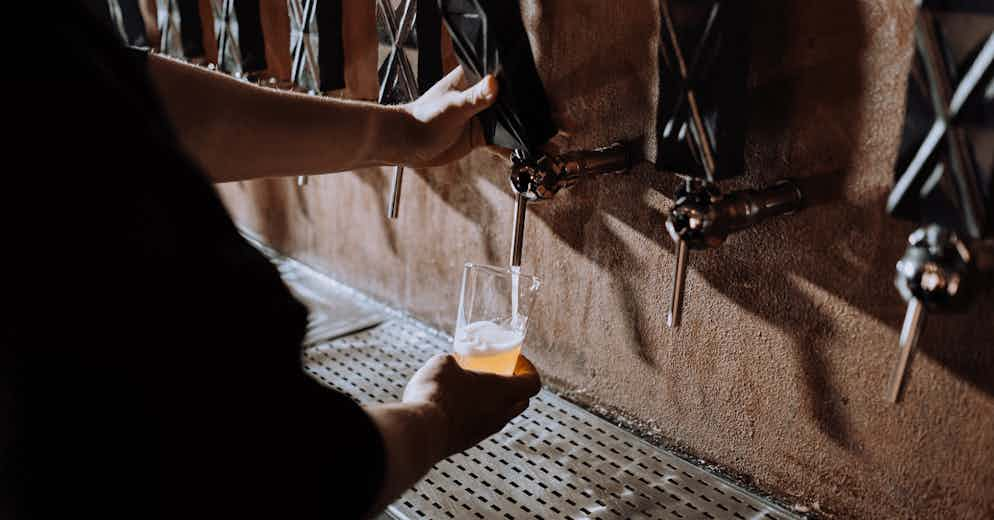How to Brew Your Own Beer
Brewing your beer at home is a great hobby that anyone can have. This guide will help you get started and make great beer consistently.

So you want to learn how to make beer? Homebrewing is no rocket science! Most beer recipes follow a standard procedure: extracting the sugars from malted grains, roasting and mashing the barley, adding the hops and yeast, fermenting, and bottling.
Homebrewing is a passionate hobby that anyone can have. As long as you enjoy it, set some space at home, and have a good dose of patience since it is a process that generally takes a few weeks. You just need the right equipment, and the sky’s the limit when it comes to styles, ingredients, and flavours you want to try when you start to make your own beer.
Brew Your Own Beer in 6 Steps
Learning how to brew your own beer is easy and fun. In this guide, we’ll walk you through the necessary beer brewing process. No brewing experience needed – just good taste!
Step 1: Prepare
First of all, you’ll need some equipment and the necessary ingredients. You can either gather everything yourself or purchase a pre-made beer making kit online.
Equipment:
- A large pot
- A filter tank
- Blender
- Bottles
Basic ingredients:
Quantities vary depending on the recipe and type of beer. But it is generally considered that for every liter of beer, you need.
- 175 grams of barley
- 3 grams of hops
- 1 gram of yeast
- 6 grams of sugar
- Water
Step 2: Germination and Malting
Beer is made out of grains, the most common one being barley. The first step in the malting process is to germinate the barley, ferment sugars and yeast nutrients.
Malting is obtained from washing the barley; it should be left for 48 hours in a container with water. The seeds start germination, thanks to the moisture that they have absorbed. Afterward, the seeds should be left in the container for at least five days at room temperature. You’ll know the seeds have finished their germination process when roots sprout and are the same length as the grain.
Step 3: Roasting
The next step is to let the sprouted grain dry completely, and then you’ll begin the process of roasting it. This can be done on any kitchen oven. This is what will give color to your beer, the more you toast your grain, the darker the color. Beers go from the blondest, which are generally softer, to the darker and more intense. You should allow the barley to toast for 10 to 60 minutes.
Step 4: Extracting
Once you have completed steps 1-3, you’ll have your malt. Malt is the product left over after the grain is allowed to sprout, dried, and roasted. Next, you’ll need to extract the malt by grinding it on a blender with purified water. They need to be stirred for at least 90 minutes at 145-160 ºF. This process turns the starch into fermented sugars. At the end of this process, you’ll need to separate the solid remains from the liquid. Make sure to circulate the fluid a few times to clean it thoroughly.
Step 5: Hops and Fermenting
After you’ve completed steps 1-5, you are left with the beer wort. Now it’s time for one the best parts, adding the hops! Hops are what give the beer its characteristic aroma and flavor. They should be added to the wort gradually, diluted in hot water, and the whole beer wort needs to be boiled for at least two hours.
Next, you’ll need to add the yeast; this is what turns the wort into beer. This is the last and longest step in the brewing process. The mixture should be left at a stable temperature, depending on the type of beer, in a covered container to avoid contamination, but not completely sealed.
You’ll know the fermentation process is over when the liquid’s density does not change, and it’s producing fewer or no bubbles.
Step 6: Carbonation and Bottling
Before bottling your beer, you’ll need to add sugar to the mix. Sugar mixed with the yeast produces carbon dioxide, giving the beer its characteristic gas. The last step is bottling using a filter to avoid any solid particles on the final product. Once bottled, they should be left to rest in a dark and cold place. Usually, the carbonation process takes around two weeks, sometimes even more, depending on the beer.
After this, you’ve made it; you’ve made your first batch of homemade beer! It’s a skill you can take and profit from wherever you might go! All that’s left to do is refrigerate so you can enjoy it with your friends and family. Some practice batches and promise you’ll become a brewmaster in no time, and you will love it!
About the Author
Isabella Caprario is Marketing Team Lead and does Content Marketing at Porch. She has an International MBA, and her hobbies are reading, writing, and music.
Learn the 7 secrets to making great, consistent beer!

